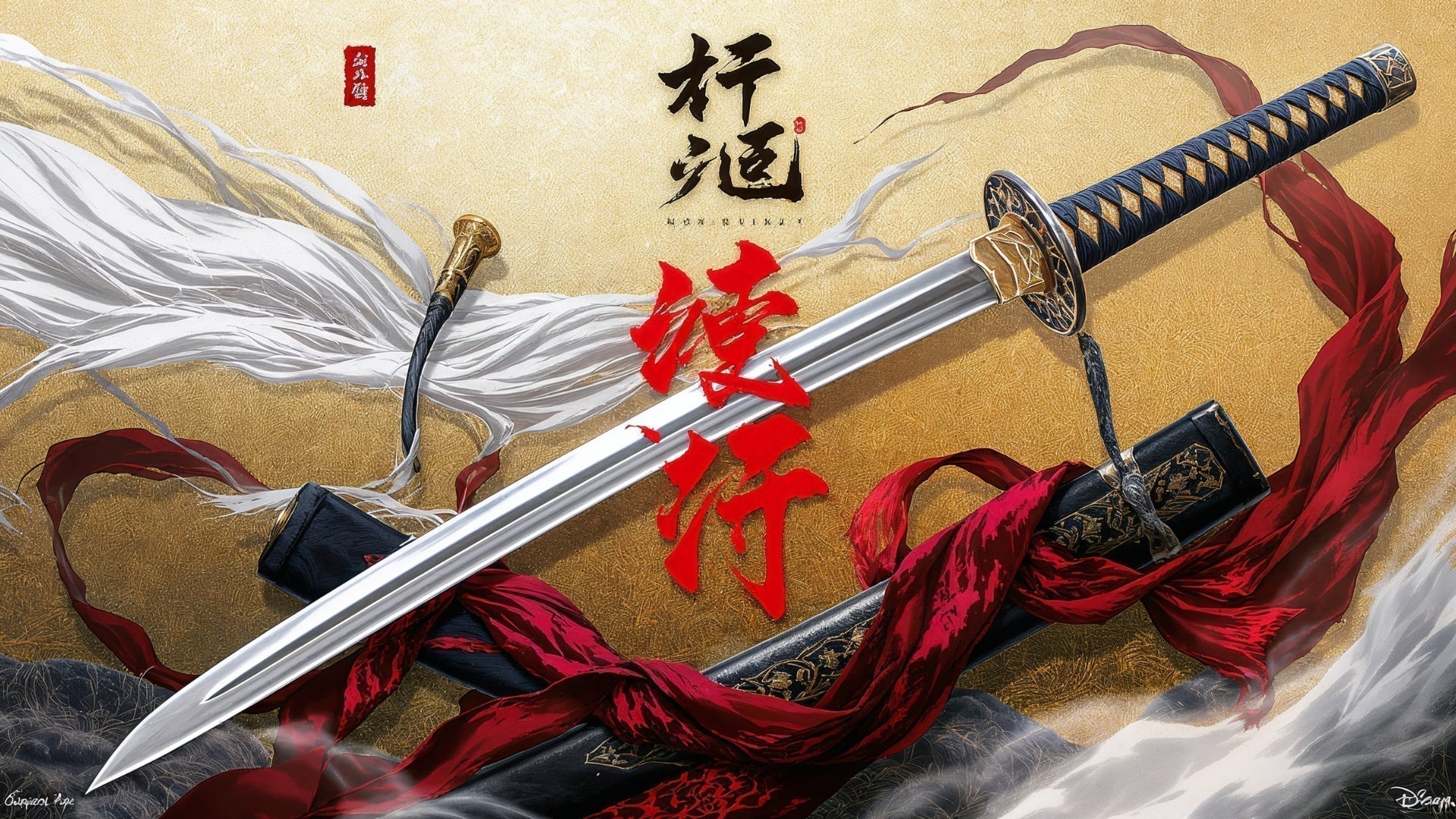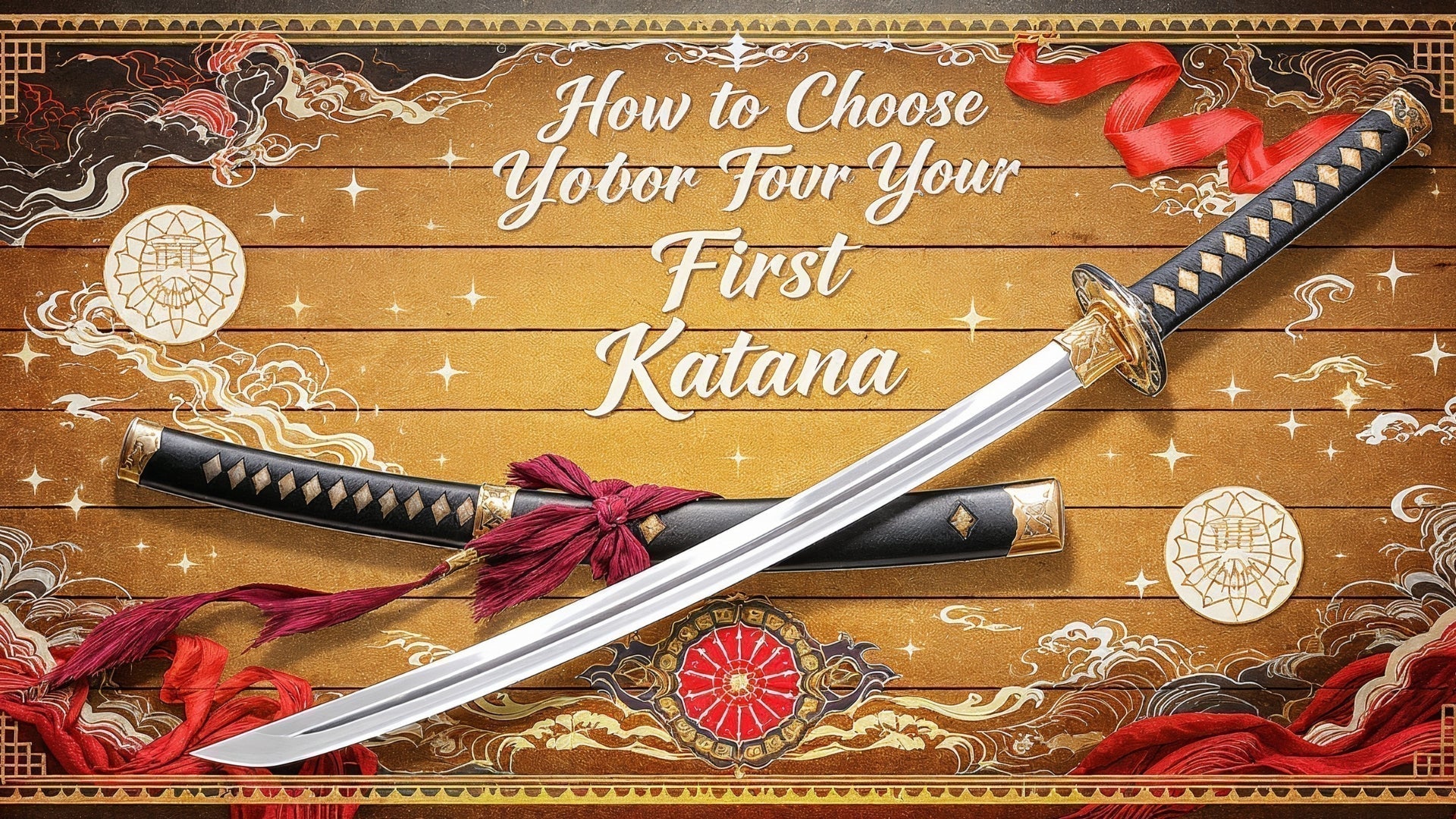For centuries, the katana has been celebrated as the ultimate symbol of the samurai. Its elegant curve, lethal sharpness, and spiritual significance make it one of the most iconic weapons in history. But before the katana became the signature sword of feudal Japan, another blade held the spotlight: the tachi. Both swords share ancestry, but they differ in purpose, construction, and cultural meaning. In this comprehensive guide, we’ll explore the origins, characteristics, evolution, and legacy of the katana and the tachi, comparing the two to understand how they shaped the samurai’s identity and Japanese history.
Origins of the Tachi: The Predecessor to the Katana
The tachi predates the katana by several centuries, with roots stretching back to the late Heian Period (794–1185). During this time, Japan was dominated by aristocratic courts, and military campaigns often involved mounted warriors. The tachi, with its pronounced curve and longer blade, was designed for slashing attacks from horseback. Its construction reflected the tactics of early samurai warfare, where cavalry charges dominated the battlefield.
Key features of the tachi included:
-
Blade length: typically 70–80 cm (27–31 inches), though some ceremonial tachi reached up to 90 cm.
-
Pronounced curvature (sori), optimized for mounted slashing.
-
Worn suspended edge-down from the belt (obi) using elaborate cords.
-
Highly decorative koshirae (fittings) that denoted the rank of the warrior.
The tachi was not only a tool of war but also a piece of art. Ornamental mountings, gold inlays, and lacquered scabbards signaled its role as a symbol of wealth and power. Tachi swords dedicated to shrines survive today, testifying to their ceremonial as well as martial significance.

The Rise of the Katana: From Cavalry to Close Combat
By the Kamakura and Muromachi periods (13th–14th centuries), Japanese warfare had shifted. Infantry skirmishes, castle sieges, and one-on-one duels replaced the cavalry-dominated battles of earlier centuries. A shorter, faster weapon became essential, giving rise to the katana.
Distinct features of the katana included:
-
Blade length: usually 60–75 cm (24–29 inches).
-
Moderate curvature, striking a balance between cutting power and speed.
-
Worn edge-up through the obi, enabling the samurai to draw and cut in a single fluid motion (iaijutsu).
-
A design emphasizing practicality and readiness in sudden encounters.
The katana became the inseparable companion of the samurai. Its wearing style alone symbolized a shift in mindset: no longer just an aristocratic status symbol, the sword was now a constant reminder of a warrior’s readiness to fight and, if necessary, to die.

Forging Differences Between Katana and Tachi
Both weapons were forged from tamahagane steel, folded repeatedly to refine its structure, remove impurities, and create distinctive hada (grain patterns). However, their forging reflected different needs:
-
Tachi: Forged longer and with a deeper curve, the balance point was farther from the hilt, giving it momentum for slashing on horseback.
-
Katana: Forged shorter with a slightly straighter profile, balanced closer to the hand for precision and speed.
Many tachi were later modified into katana by shortening the tang (nakago) and remounting the blade in new fittings. These repurposed swords, known as tachi-kiriage, demonstrate how closely related the two weapons were.

Forging Techniques: Regional Schools and Styles
Different swordsmithing schools gave birth to unique forging styles that impacted both tachi and katana. The Gokaden (Five Traditions) defined Japanese swordmaking:
-
Yamato: Practical, with straight lines and strong functionality.
-
Yamashiro: Elegant shapes, refined hamon, often linked to courtly aesthetics.
-
Bizen: Balanced swords with flamboyant hamon, widely favored among samurai.
-
Soshu: Thick, powerful blades, designed for battle resilience.
-
Mino: Blended traits, producing versatile and practical swords.
These traditions shaped both tachi and katana differently, with tachi often reflecting aristocratic elegance and katana embodying martial pragmatism.
How They Were Worn: Symbolism and Practicality
-
Tachi: Hung edge-down using suspension cords, often richly decorated. This made them slower to draw but visually striking, reinforcing their ceremonial role.
-
Katana: Thrust edge-up into the belt without cords. This revolutionary style allowed quick drawing and immediate combat response.
The way each sword was worn shaped its meaning. Tachi symbolized status and ritual, while katana symbolized identity, practicality, and personal readiness. Samurai were required to carry a daishō (pair of swords), but the katana soon eclipsed all others as the embodiment of their spirit.
Battlefield Roles and Tactical Evolution
-
Tachi: Dominated the Heian and Kamakura battlefields, especially for cavalry charges. Its deep curvature allowed sweeping strikes from horseback.
-
Katana: Gained prominence during the Sengoku and Edo periods, excelling in duels, ambushes, and close combat within castles or urban areas.
As armor technology advanced and firearms spread, the katana proved more adaptable than the tachi, cementing its dominance as the samurai’s sidearm.

The Role of Tachi in the Imperial Court
Beyond the battlefield, tachi were used in imperial and aristocratic ceremonies. Emperors and shoguns often commissioned elaborately decorated tachi to be offered to shrines or presented as diplomatic gifts. Their opulence reinforced social hierarchy and reflected the divine status of the emperor. Even today, some shrines house ancient tachi offered by emperors centuries ago.
Cultural and Spiritual Significance
Both swords carried immense symbolic weight:
-
Tachi: Often offered to Shinto shrines as sacred gifts, representing nobility, aristocracy, and elegance.
-
Katana: Revered as the soul of the samurai, embodying Bushidō values such as loyalty, discipline, and honor.
The transition from tachi to katana mirrored Japan’s cultural shift from elite courtly traditions to the pragmatic warrior ethos.
The Evolution from Tachi to Katana
The transition from tachi to katana was gradual, spanning centuries. Early prototypes like the uchigatana bridged the gap, combining moderate curvature with the edge-up wearing style. This weapon became more practical for infantry combat. By the Muromachi period, the katana had firmly established itself as the weapon of choice, but many tachi were repurposed and adapted, showing a clear evolutionary lineage.
This evolution reflects how adaptable Japanese swordsmiths were in responding to new military tactics and cultural needs.
Military Evolution: From Mounted Cavalry to Urban Warfare
The decline of the tachi was also tied to changes in military strategy. With the introduction of firearms in the 16th century, heavy cavalry lost its dominance. Castles and fortified towns became the new centers of conflict. The katana’s shorter length and rapid draw made it ideal for these tighter, urban battlefields, unlike the tachi, which excelled in open cavalry charges. This shift marked a broader transformation in samurai warfare and strategy.
Katana vs Tachi: A Comparative Table
| Feature | Tachi | Katana |
|---|---|---|
| Era of prominence | Heian–Kamakura (10th–13th century) | Muromachi–Edo (14th–19th century) |
| Blade length | 70–80 cm | 60–75 cm |
| Curvature | Deep | Moderate |
| Worn | Edge-down (suspended) | Edge-up (through belt) |
| Combat style | Cavalry slashing | Quick-draw, versatile fighting |
| Symbolism | Aristocracy, ceremony | Samurai soul, practicality |

Tachi in Ceremonies and Rituals
Even after its decline on the battlefield, the tachi retained ceremonial importance. Many were used as imperial gifts, wedding offerings, or shrine dedications. Their ornate mountings made them symbols of prestige in religious and cultural events. Some shrines still display ancient tachi as sacred treasures.
Katana and Tachi in Japanese Literature and Theater
Both swords appear frequently in Japanese literature and theater. The tachi is celebrated in works like The Tale of the Heike, associated with courtly warriors and their tragic heroism. The katana dominates Edo-period kabuki and ukiyo-e, symbolizing the life-and-death struggles of the everyday samurai. These depictions reinforced the identity of each sword and cemented their place in Japanese cultural memory.
Katana and Tachi in Modern Museums and Exhibitions
Today, both katana and tachi are preserved and displayed in major museums around the world. The Tokyo National Museum and Kyoto National Museum feature some of Japan’s most treasured swords, while international institutions like the British Museum and the Metropolitan Museum of Art in New York exhibit blades to global audiences. These exhibitions highlight not only the artistry of the weapons but also their role in Japanese identity and heritage.
Case Studies: Famous Katana and Tachi in History
-
Kogarasu Maru: A unique hybrid blade often seen as the bridge between tachi and katana. With its double-edged tip and elegant curve, it is one of Japan’s most celebrated swords.
-
The Tachi of Emperor Go-Toba: Commissioned by the emperor himself, these swords represented the highest standard of craftsmanship and divine authority.
-
Masamune’s Katana: Revered worldwide, Masamune’s blades set the standard for the katana’s reputation as a perfect balance of strength and beauty.
These famous swords provide tangible examples of the cultural and historical weight carried by both forms.
Market Value and Collecting Trends
In today’s collectors’ market:
-
Tachi: Intact examples with original koshirae are extremely rare and fetch high prices, sometimes exceeding $100,000.
-
Katana: While more numerous, blades by famous smiths like Masamune or Kanemoto are equally prized. A verified, papered katana can also sell for six figures.
Auction houses like Christie’s and Sotheby’s have sold ceremonial tachi for record-breaking sums. Collectors prize them for rarity, artistry, and historical significance.
Influence on Modern Martial Arts
The katana is central to martial arts like Kendo, Iaido, and Kenjutsu, which focus on speed, precision, and discipline. The tachi, though less used, survives in older schools like Tenshin Shōden Katori Shintō-ryū, ensuring its combat methods are not forgotten.

FAQ: Katana vs Tachi
Which came first, the tachi or the katana?
The tachi predates the katana, originating in the Heian period.
Why was the katana worn edge-up?
It allowed faster drawing and striking, ideal for sudden encounters.
Are tachi still made today?
Yes, though mainly as ceremonial reproductions by licensed swordsmiths.
Can a tachi be converted into a katana?
Yes, many tachi were shortened and remounted as katana over the centuries.
Which is more valuable today?
Both are prized, but intact tachi with original fittings are especially rare.
Do martial arts use the tachi?
Yes, though rarely. Some koryū schools preserve techniques specifically for the tachi.
Were tachi only for cavalry?
Primarily yes, but some infantry also carried them, especially in earlier periods.
What is the uchigatana?
A transitional form between tachi and katana, bridging the design evolution.
Did samurai carry both tachi and katana?
No, the tachi was gradually replaced by the katana, though some ceremonial contexts saw both used.
Which sword better represents Bushidō?
The katana, as it became synonymous with the samurai’s soul and way of life.
What were ceremonial tachi used for?
They were dedicated at shrines or given as gifts during important events.
How do collectors verify authenticity?
Through NBTHK papers, mei inscriptions, and historical provenance.
Which sword is more practical in modern martial arts?
The katana, thanks to its influence in Kendo and Iaido.
Why are tachi rarer in collections?
Fewer have survived intact, as many were remounted into katana.
What is the weight difference between tachi and katana?
Tachi were generally heavier due to longer blades and ornate fittings, while katana were lighter and balanced for speed.
Did women samurai use tachi or katana?
Onna-bugeisha (female warriors) more commonly used naginata and shorter swords, but ceremonial tachi were sometimes part of noble households.

Conclusion: Two Blades, One Legacy
The katana and the tachi represent different eras of Japanese warfare and culture. The tachi, with its aristocratic elegance and cavalry function, symbolizes Japan’s early feudal might. The katana, with its efficiency, speed, and philosophical depth, represents the matured soul of the samurai. Together, they tell the story of how Japan’s warriors evolved—how they adapted their weapons to reflect both practical needs and spiritual ideals.



Share:
The Art of Katana Forging
How to Choose Your First Katana: Complete Beginner’s Guide